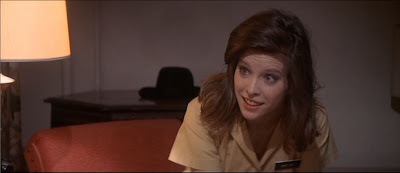The track record for pop recording artists successfully transitioning to motion pictures is checkered at best. For every A Hard Day's Night or The Rose, there's a Shanghai Surprise or Under the Cherry Moon. If the more successful examples of this often painful sub-genre have anything in common, it's that they tend to be vehicles that don't unduly strain the talents of the artist in question and, contextually speaking, serve to augment and exploit the said artist's already firmly established public image.
Elvis merely had to channel his stage persona for Jailhouse Rock; Roger Daltrey really WAS Tommy, and 70's pop sensation David Bowie found the perfect vehicle for his otherworldly Ziggy Stardust/ Space Oddity image in Nicolas Roeg's dreamily poetic adaptation of Walter Trevis' sci-fi classic: The Man Who Fell to Earth.
David Bowie
Splashdown
Armed with the advanced technology and intellect characteristic of his people, the determinedly pragmatic alien (who goes by the name of Thomas Jerome Newton and carries a British passport) is rendered defenseless by his inability to comprehend the complex and sometimes paradoxical workings of the human soul.
A treatise on everything from alienation, longing, corruption, ambition, and hope, The Man Who Fell to Earth is that most intriguing brand of science fiction film: a futuristic drama that takes into account the fact that the technological advancements of science seem never rise above the ethical limitations of man.
A world without water, a family left behind
WHAT I LOVE ABOUT THIS FILM
I really admire how The Man Who Fell to Earth plays with the concept of time. The story has the feel and scope of an epic, but there is no reference to just how much time has elapsed. Major events unfurl, and inventions reorganize lives, yet Bowie's unchanging flawlessness stands in poignant counterpoint to the aging decay of those around him. Roeg's employment of fluid time imbues Tevis' novel with an abstract metaphysical richness, making this somewhat familiar "fish-out-of-water" tale shimmer with keen human insights and finely observed perceptions about loneliness and the universal need to connect.
Close without Contact
PERFORMANCES
Whether by design or luck, surrounding the relatively stiff and inexpressive Bowie with a team of idiosyncratically naturalistic actors (Rip Torn, Candy Clark, & Buck Henry) evocatively underscores Bowie's unerasable "otherness" as the alien and brings into tragic relief his unending estrangement from those he seeks to understand.
Rip Torn's performance as the disillusioned idealist Nathan Bryce is hands-down the film's best performance, but Candy Clark is the film's emotional center. As Mary-Lou, a small-town girl lonelier and more isolated than the alien she falls in love with, Clark does some very intelligent things to bring dimension to a character who's none-too-bright.
Candy Clark as Mary-Lou: Looking for Love
A plea to be seen instead of just being watched
Mary-Lou & Nathan find one another in old age"I don't want her to get lonely."
THE STUFF OF FANTASY
There is just something so right about the conceit that an alien from another planet would look like an orange-haired British pop star. It adds yet another layer of pop-cultural awareness to a film that equates human greed, ambition, and folly to a preoccupation with surface appearance and the inability to actually see what is right before our eyes.
Rip Torn: "Are you a Lithuanian?"
Bowie: "Don't be suspicious."
THE STUFF OF DREAMS
The Man Who Fell to Earth is a film filled with fluid imagery, both literally and figuratively. Liquids, such as water, alcohol, and bodily fluids, are a major visual motif and subtextual theme.
WHAT FUELED MY DREAMS
Having lived for more than 50 years, I've seen my share of technological advancements. Sci-fi movies tend to envision the future as either some utopian ideal where all our problems are solved by technology or as a nightmarish world of "1984" -ish technological enslavement. My experience has been that no matter how advanced the invention, we humans have a way of modifying it to accommodate our basest natures.
The Man Who Fell to Earth doesn't position itself in any easily identified point in time and tells a tale of a savior who comes to Earth, yet the most use we have for him is exploitative and corporate in nature. Money and power rule, and while the corrupt and ambitious move the world along to its inevitable annihilation, people fumble about trying to connect while blind to ever discovering how to do so.
You can keep your Star Wars gadget-fetishism and your Close Encounters of the Third Kind wish-fulfillment fantasy; I'll take the wistful vision of space travel offered by The Man Who Fell to Earth. A film whose catchline could have been: "In space, no one can hear you cry."
"I think maybe Mr. Newton has had enough."
 |
| VOGUE Theater, San Francisco 1976 Promotional check which entitled the recipient to $1 off towards the purchase of a The Man Who Fell To Earth movie poster |
Copyright © Ken Anderson 2009 - 2010















































.JPG)



.JPG)




.JPG)



